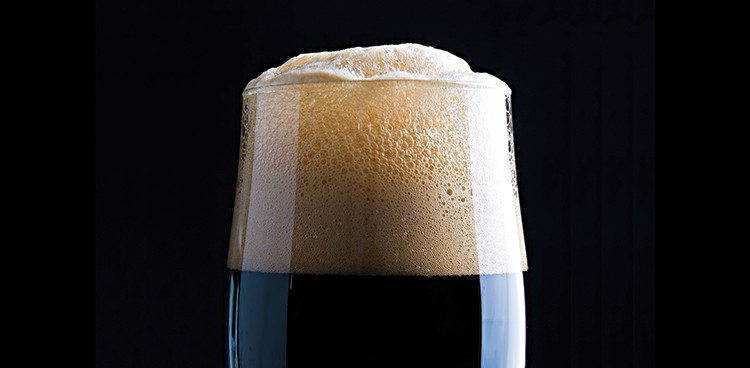
Right now in taverns worldwide, there’s a ritual being repeated. Drinkers are sidling up to bars, sitting on stools, and ordering a particular stout. While it takes less than ten seconds to pour a typical pint, this dark brew requires a bartender’s patient hand. Seconds stack into minutes as the raven-colored beer slithers from the tap like maple syrup, the bubbles racing upward to form a head as creamy and luscious as a latte’s.
“My, that’s a good-looking Guinness,” the grateful customer will say, lustily sipping a centuries-old tradition. Since the late 18th century, beer drinkers have happily turned to the dark side, hoisting billions of pints of that inky Irish favorite. But despite Guinness’s international popularity, few fans understand the brewery’s role in creating a singular beer style: the roasty, deceptively light-bodied, compulsively drinkable dry Irish stout.
In 1759, entrepreneurial Irishman Arthur Guinness commandeered an unused brewery at Dublin’s St. James’s Gate. Initially, he brewed his version of the era’s popular British porters, which were often called “stout” to describe their potency. By the early 19th century, maltsters (the men who roast grain) discovered new techniques to blacken barley malt, thus imparting an onyx tint and subtle roastiness to beer. Taking advantage of these technological advancements, in 1821 Arthur Guinness II used darker grains to create a recipe that, over the decades, evolved into the creamy Guinness drinkers adore today.
While Guinness is among the best-known Irish dry stouts—along with Emerald Isle offerings Murphy’s, Beamish, and O’Hara’s—American craft brewers have also begun releasing their riffs on the classic quaff. Great versions hail from Maine, where Gritty McDuff’s and Shipyard Brewing Co. brew, respectively, the Black Fly Stout and Blue Fin Stout. In Pennsylvania you’ll find Sly Fox, which offers O’Reilly’s Stout. On the West Coast, California’s North Coast Brewing Company turns out the terrific Old No. 38 Stout, while Wisconsin’s Furthermore Beer makes the tasty Three Feet Deep.
No matter which dry stout you select, you’ll want to find a cheese to match the style’s bitterness and coffee-like quality. Opt for a nutty-sweet Dubliner cheese hailing from—where else?—Ireland. Marketed under the Kerrygold brand in America, the flagship Dubliner is a delicious option, as well as the Dubliner with Irish Stout, which incorporates beer concentrate. You can also look to try smooth, caramel-nuanced Coolea, which is comparable to gouda, from Coolea Farmhouse Cheese in County Cork. Upping the flavor intensity, match Cashel Blue from Ireland with Guinness Foreign Extra Stout—a highly hopped beer that packs a decidedly roasty punch. (If regular Guinness were a cup of coffee, then the FES version would be a supercharged espresso.) Finally, I can’t resist recommending a personal favorite pair: dry stout and raw oysters. The brew’s roastiness perfectly offsets the bivalves’ salinity. So grab a few wedges of cheese and a half-dozen ocean-fresh oysters, and give these five Irish dry stouts a spin:
5 to Try
Guinness
Guinness is a rich and velvety delight that, despite its dark hue, drinks deceptively light and nimble. It tastes a bit bittersweet with roasted-coffee flavors too, but the thick, silky head ties everything together and makes Guinness a nice, easy ride.
Shipyard Brewing Co. Blue Fin Stout
First released by the Portland, Maine, brewery in 1993, Blue Fin remains a delicious take on the traditional style. The midnight-dark stout is capped by a rich beige head, which clings to your lips as you sip the silky brew with flavors of rich malt and bittersweet chocolate and a crisp, bitter aftertaste.
Starr Hill Dark Starr Stout
Virginia’s Starr Hill makes one of America’s finest Irish dry stouts. The secret is heaps of roasted barley, which give Dark Starr a chocolaty, coffee-like character while retaining a nimble body. In the words of the brewery, “This signature brew pours like velvet and drinks like a slice of grandma’s pumpernickel bread.”
North Coast Brewing Co. Old No. 38 Stout
Named for a retired steam engine that once rode a line through the redwoods, this California-made stout comes from a bottle the color of midnight. It has a strong aroma of sweet chocolate and tastes of well-roasted malts, dark fruits, and java. The beer goes down smooth and creamy, with a refreshingly dry close.
Porterhouse Brewing Co. Wrasslers XXXX Full-On Stout
Porterhouse’s Wrassler comes into the glass with a crown of khaki foam over an obsidian pour and, thanks to a quartet of hops, an assertively bitter scent. But the bitterness never overwhelms the stout; it drinks dry and balanced, with a flavor charge led by coffee, baker’s chocolate, and loads of roasted malt.





